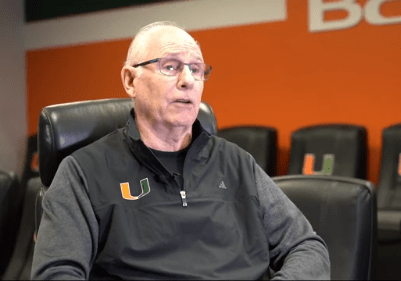Jim Larranaga’s 2025 compensation of $2.562 million represents a remarkably balanced combination of value, longevity, and strategic continuity in a time when coaching contracts are examined with the same rigor as election campaigns. While some high-profile coaches make news for exceeding wage caps, Larranaga’s compensation speaks to a more nuanced story that is focused on institutional alignment, legacy, and trust.

Larranaga has transformed the men’s basketball program at the University of Miami over his twelve years there, leading the Hurricanes from a mediocre conference team to a contender in the Final Four. His 270–166 record with Miami may not seem impressive at first glance, but when compared to the ACC’s competition and recruitment difficulties, it represents an exceptionally successful coaching career.
Jim Larranaga: Biography, Career & Salary Snapshot
| Category | Details |
|---|---|
| Full Name | Jim Larrañaga |
| Role | Head Coach, University of Miami Men’s Basketball |
| Annual Salary (2025) | $2.562 million |
| Contract Status | Extended through 2026–27 season |
| Total NCAA Career Wins | 712 (Ranked 26th in Division I history) |
| Miami Coaching Record | 270–166 |
| George Mason Record | 273–164 |
| Bowling Green Record | 170–144 |
| NCAA Tournament Appearances (Miami) | 6 |
| Final Four Appearance | 2023 NCAA Tournament |
| Official Profile |
Miami signed Larranaga to a two-year agreement shortly before the 2022 NCAA Tournament began, reaffirming their faith in him. The university then extended the contract by a another season, until 2026–2027, after the Hurricanes made an unprecedented run to the Final Four in 2023. This development makes it very evident that Miami is making investments in culture, mentoring, and long-term development in addition to victories.
Even if his current salary is competitive, it is still far less than some of his peers—coaches whose yearly incomes routinely surpass $5 or even $6 million. This contrast is deceptive, though. Few coaches have been able to continuously develop and adapt throughout decades of play, but seven coaches in the 2023 Sweet 16 made more money than Larranaga. He is a coach who has frequently adjusted his techniques to accommodate contemporary rosters, NIL shifts, and evolving athlete expectations; he is not just a holdover from a bygone era.
It is evident that colleges are starting to prefer coaches with a longer-term outlook over those who produce quick bursts of success. This tendency is seen throughout NCAA Division I athletics. Larranaga now occupies a special place—among the final living heavyweights of college basketball—especially in light of the recent retirements of renowned players like Jim Boeheim and Mike Krzyzewski. Yet, as seen by Miami’s three-season postseason triumphs that defined the program, he keeps pushing the envelope rather than settling for past achievements.
When his entire coaching arc is considered, it is an especially interesting journey. Larranaga played for 14 seasons at George Mason prior to joining Miami, where he was the leader of a now-famous Cinderella run to the Final Four in 2006. Not only did that one season make George Mason famous, but it also changed the national perception of mid-major programs. Even earlier, he spent 11 seasons honing the developmental processes that would eventually become his coaching identity at Bowling Green. His combined influence at these schools, which was evident in his 443 victories prior to coming to Coral Gables, made him a remarkably resilient program architect.
Larranaga has continued to change in recent years, especially with the swift start of the transfer portal era and the growth of NIL-driven hiring. To attract recruits or media attention, younger coaches might try more performative strategies, but Larranaga has gravitated toward a philosophy of consistency and relationship depth. This strategy has shown to be quite effective in keeping elite talent while upholding a strict framework that values team unity.
Even more striking is how, in spite of his achievements, Larranaga’s coaching brand has remained incredibly low-profile. His manner is not that of a showman, but that of a professor. He doesn’t hurl chairs in angry outbursts or pace the sidelines in expensive outfits. He earns respect by being prepared rather than by using showmanship. Ironically, he has gained something extremely uncommon in university athletics—sustained institutional loyalty—by virtue of his modest excellence, which has turned become his calling card.
In terms of money, the choice to give him $2.562 million a year is not just a reward; it is a very secure investment. The return is particularly evident when compared to Miami’s success indicators, which include wins, tournament appearances, recruitment stability, and alumni engagement. He doesn’t rely on fanfare for his contract. It depends on the outcome. Additionally, it makes sense from the perspective of program management. The institution has chosen a coach who creates teams, not headlines, rather than spending over $5 million on a hotshot with a viral TikTok following.
From a social perspective, Larranaga’s pay says a lot about how people view leadership. He presents a radically different story in a culture that frequently celebrates job switching and ongoing reinvention. He is a representation of professional tenacity, demonstrating how adhering to a core set of principles that have been modified throughout time may pay off in the long run. His journey is especially helpful for aspiring coaches or young professionals as a model for how perseverance and method may triumph over glitz and celebrity.
This does not imply that Larranaga is impervious to pressure. The scrutiny increases along with expectations, especially following Miami’s Final Four milestone. It would be possible to use every tournament defeat or off-season slump as justification for not extending his contract. However, Larranaga’s influence is remarkably varied—spread across decades, programs, and changing periods of collegiate sport—unlike others whose legacies are based on isolated incidents.
It may be argued that he does not have the same national prominence as more theatrical NCAA figures because of his measured public presence. But in coaching circles, his name is a byword for self-control, modesty, and creativity. Larranaga has accomplished what few can: he has created a legacy that feels both earned and profoundly educational through shrewd alliances, steady player development, and an unwavering concentration on the fundamentals.
Consequently, his coaching approach and compensation make him a symbol of what is still feasible in the increasingly marketed world of collegiate athletics. In the midst of corporate sponsorships, NIL collectives, and billion-dollar TV deals, Larranaga serves as a reminder that maintaining composure is still important. that a skilled coach can have just as much of an influence as a skilled salesperson. that creating a team is still more important than creating a brand.
